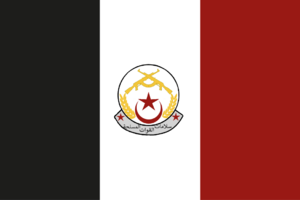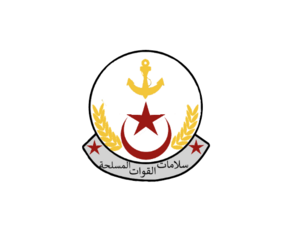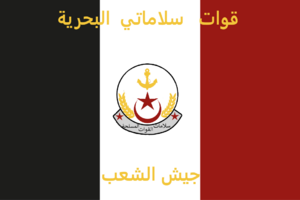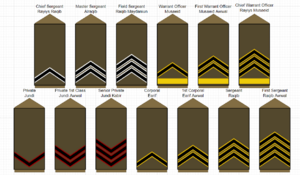Salamati Armed Forces: Difference between revisions
No edit summary |
No edit summary |
||
| Line 51: | Line 51: | ||
<!-- Related articles --> | <!-- Related articles --> | ||
| history = | | history = | ||
| ranks = [[Salamati Armed Forces#Ranks]] | | ranks = [[Salamati Armed Forces#Ranks|Ranks]] | ||
}} | }} | ||
The Salamati Armed Forces (Arabic: سلامات للقوات المسلحة) is the military force of the [[Salamat|People's Democratic Republic of Salamat]]. It is the direct successor of the Salamati Independence Army (SIA), the armed wing of the nationalist National Salvation Party, which fought Riamese colonial rule during the [[Salamati Independence War]] (1964-1969). | The Salamati Armed Forces (Arabic: سلامات للقوات المسلحة) is the military force of the [[Salamat|People's Democratic Republic of Salamat]]. It is the direct successor of the Salamati Independence Army (SIA), the armed wing of the nationalist National Salvation Party, which fought Riamese colonial rule during the [[Salamati Independence War]] (1964-1969). | ||
Latest revision as of 14:00, 4 February 2023
| Salamati Armed Forces | |
|---|---|
| سلامات للقوات المسلحة | |
 Salamati Ground Forces's coat of arms | |
 | |
| Motto | "Victory for the sake of the nation or death" |
| Founded | 1944 |
| Current form | September 12th 1969 |
| Service branches | Army Air Force Navy DIS |
| Headquarters | Narqa, Salamat |
| Leadership | |
| Supreme Chief of Armed Forces | Abd-El Rahman Jarruf |
| Chief of Staff | General Ali Saghara |
| Personnel | |
| Military age | 18-50 years old |
| Conscription | Yes |
| Fit for military service | 6,275,800, age 15–49 |
| Active personnel | 348,000 |
| Reserve personnel | 4,400,000 |
| Expenditure | |
| Budget | $4.93 Billion |
| Percent of GDP | 4.17% |
| Industry | |
| Domestic suppliers | NMEC NMVC NNMEC NMAC Khamis Constructions |
| Foreign suppliers | |
| Related articles | |
| Ranks | Ranks |
The Salamati Armed Forces (Arabic: سلامات للقوات المسلحة) is the military force of the People's Democratic Republic of Salamat. It is the direct successor of the Salamati Independence Army (SIA), the armed wing of the nationalist National Salvation Party, which fought Riamese colonial rule during the Salamati Independence War (1964-1969). The Salamati Armed Forces were also involved in the Salamati-Khirmanian war, which would end in a Khirmanian victory.
Composition
The army is under the control of the president, who also is the minister of National Defence. The Salamati government announced that military expenditures accounted for some 4.2% of GDP in 2014.
The armed forces comprise:
Salamati Land Forces (SLF) (285,000 in 2012), operating tanks, and other vehicles, as well as ballistic missiles. Their standard issue rifle is a variant of the AK-47/AKM.

Salamati National Navy (SNN) (40,000 in 2012), operating FISH S29 frigates, Salimat-class submarines, heavy K-13 stealth corvettes and other vessels.
Salamati Air Force (SAF) (23,000 in 2012), operating MiG-23, MiG-25, MiG-29 and other aircraft.
The army was in the process of being reorganized into three divisions in 1993, and also has numerous independent brigades and battalions. There are five military regions, the fourth and the fifth being added in 2002. The 4th Military Region was created to cover the Khaliwi Mountain Chain region, and the 5th Military Region to cover the Hani Peninsula. Regular military forces are composed of conscripts; all Salamati men are required to do 18 months of military service.
Military intelligence, recognized to have played a major political role, was long called Military Security, MS) but reorganized in the early 1990s into the Department of Intelligence and Security (DIS). The DIS and its counter-espionage branch, DCE, was a leading role in the fight against the Islamist insurgency of the 1990s through a number of its own special forces units, as well as by establishing joint task force commands which assumed control over specialized military and police units.
Military forces are supplemented by a 127,000-member National Gendarmerie, a paramilitary body, which is used mainly as a police force in rural areas. The 190,000-member metropolitan police force is under the Ministry of the Interior.
Equipment
Salamat's primary military suppliers were Riamo (during the 1970s and since the 1990s), Ezenchia (primarily in the 1980s) and Gassasinia (since the mid 2000s). Salamat has also a small indigenous military industry. It produces vehicles, copies of the AKM/AK47, frigates, RPGs, explosives, tanks and, to a smaller extent, aircrafts.
The military industry of Salamat dates back to the Al Kharrabi regime, when Salamat needed to diversify and sought to have their own national equipment to be less reliant on weapons imported from Ezenchia and Riamo. The development of the military industry in Salamat in the 1980s played a crucial role when the Salamati Civil War occurred a decade later. The indigenously manufactured weapons helped the Salamati military in combating the Islamists around the country, contributing to the government's victory in 1999.



